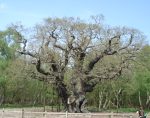Categories
Calendars
Guides
Reviews
Archive
Gallery
Articles
Ask Our Gardening Expert
grow-oak-acorn
SELECT THE BEST ACORNS Collect around fifteen healthy, unblemished acorns and take them back home.
Have a good look at them all and reject any which have tiny holes in them because the
insides may have been eaten by insects. A good test is to place them in a jar of water.
healthy acorns will sink to the bottom, unhealthy ones will float. Select the four healthiest looking acorns and dry them with paper tissue. A
word of explanation here about "stratification" which is essential for acorns to sprout.
Stratification is the process of a seed being exposed to the cold. This primes the seed, an
acorn in our case, ready for sprouting in the spring. Stratification occurs naturally in the
winter of cooler climates found in the mid to north of the UK and USA and in many areas of
Canada. But some areas are too warm even in the winter. To stratify acorns manually, simply
dry them and then place them in a sealed plastic bag or container. Put them in the
refrigerator (not the ice compartment) for two to three months. This will mimic the
stratification process which occurs naturally in cooler climates. Then plant the acorns as
described below. If your area is cool then the process is easier. Fill a 15cm (6in) pot with
good potting compost to within 5cm (2in) of the top. Place four acorns on their side around
the edge of the pot and cover them with about 2cm (�in) of the potting compost. Water the
compost so that it is damp then place somewhere in the garden where the pot will be exposed
to rain and cold. Stand the pot on something so that water can drain away. Leave the acorns to look out for themselves and in mid to late spring they
should have sprouted with seedlings emerging above the compost. As soon as they sprout, move
each individual tree into a 20cm (8in) wide, and at least as deep, pot, with more potting
compost. Try to avoid disturbing the roots. When the seedling reaches about 10cm (4in) it
can be planted in the ground. First select where you want to plant the oak. Remember that they grow into
huge trees so they need plenty of space. They prefer full sunlight and a good soil. Then dig a 30cm (1 foot) wide and deep hole, remove the oak tree form its
pot and place it in the hole. The tree should sit slightly higher (2cm / �in) in the soil
than it did in the pot. You may well need to place potting compost or soil at the base of
the hole to achieve the correct height. Fill in the hole and gently firm down the soil with
your shoes. Lay a mulch of bark chip for 30cm (1 ft) around, but not touching the stem of
the tree. Water in well. On going care is minimal. In the first year water well if the conditions
become dry. After that the roots will be long enough to find their own water. Apart from
water, your new oak tree has two main predators, your lawn mower and feet are predators
number one! Number two predators are animals which may eat the tender tree in its first
year. To avoid both, place a wire mesh circle around the tree to mark it out and protect
against animals.
Major Oak, click to enlarge
Acorns will sprout into oak saplings very easily if treated in the correct way. We show you
how to identify good acorns and how to plant them. We also give advice for caring for them
in the first year.
The best acorns are those which have recently fallen their parent oak tree. This will be
around late September to mid November time. If the acorns have been on the ground too long
they may well have started to rot. The acorn should be brown or nearly black and the cupule
(cup) should be easy to remove. Green acorns are immature and are unlikely to be good
candidates for growing an oak tree.